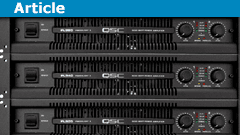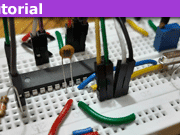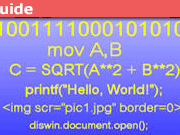Studio in a Box: Learn About Digital Modeling Amplifiers
Table of Contents
Key Points
- Digital Signal Processing (DSP) was introduced in the mid–Seventies, allowing musicians to simulate the acoustic properties of instruments and analog effects.
- Up until recently, a guitarist’s sounds were limited to the gear available, requiring vintage gear for certain sounds.
- Recent advances in microprocessor power have allowed current amplifiers to closely match the sound of classic gear and give musicians access to a full sonic palette of sounds at a fraction of the cost. Modeling amps and pre–amps are now available to mimic the responses of analog gear, allowing musicians access to multiple amplifier sounds and digital effects.
- Fender’s Cyber–Twin amp is an example of a high–end modeling amplifier that provides the sound of 35 different amplifiers, digital effects and the ability to switch sounds via a MIDI footswitch.
- Line 6 POD is a portable, digital device that contains many of the same features as larger modeling amps and is popular for recording song demos.
- Rocktron Replitone amp is an example of a mid–priced model that has the capability to switch between different amp sounds, has multiple outputs
Musical-recording age
Since the dawn of the musical-recording age, the preferred method of recording guitars has been to set up microphones in front of amplifiers and capture the sounds produced. This carried the limitations of eliminating the electromagnetic signal bleed from the amplifier, the temperamental nature of analog equipment, and placing the microphone so as to properly reproduce the sounds an audience would hear. Some of the difficulties of this method were addressed during the mid-Seventies in the form of Digital Signal Processing (DSP in digital audio), which allowed musicians to simulate the acoustic properties of instruments, such as the way sounds bounce off the walls of different-sized rooms or concert halls. Further, certain analog effects such as distortion and delay could be replicated, without the hassle of vacuum tubes and magnetic tape.
However, up until the last few years, the gear available to the musician limited a guitarist’s sounds to a certain degree. If you wanted to sound like a classic rock band, you often had to hunt down vintage gear. Nothing on earth would give you the classic crunch of, say, Jimmy Page, short of buying a Gibson Les Paul and sending the signal through a Marshall amp. A digital simulation was, by definition, a poor substitute for the real thing. A digital signal sounded cold and lifeless compared to its analog counterpart.
All that has changed, however. Recent advances in microprocessor power, plus some engineering magic, have not only allowed current amplifiers to closely match the sound of classic gear, but has allowed guitarists the luxury of a very full sonic palette of sounds at a fraction of the cost of buying gear for different needs. Current amps, called modeling amps for their ability to mimic the responses of analog gear, allow a musician access to multiple amplifier sounds, as well as digital effects, in a single compact and economical package. Most modeling amps come in at under $1500 and can accurately ape the sonic signature of several tens of thousands of dollars worth of gear. Even better, there are many pre-amps (signal processors that come before the amplification stage) that can make your older amp sound like any of a dozen or more classic and modern amps.
How does this work exactly?
Basically, the engineers have examined the components of traditional amplifiers and the ways that they interact, and reduced them to digital algorithms that seek to mimic the character of each amplifier. The final goal is to make a computerized signal reproduce the unique ways that different combinations of analog parts function as a whole. For instance, when a traditional amp is turned up, the tubes and/or speakers begin to overload, causing distortion and feedback, and the computer chips attempt to capture nuances such as this. Now, for the purist, no digital signal will ever replace a vintage amp…but for the less-traditional musician (especially on a limited budget!), getting 90% of the sound of a dozen amps is more useful than having to rely on a single amp to get all your sounds.
Probably the current ‘king of the hill’ in modeling amplifiers comes from Fender, long a leader in guitar and amplifier technology. Their Cyber-Twin amp, using a combination of analog tubes and high-speed algorithms, produces the sounds of 35 different amplifiers (including many Fender models from the past 50 years), includes digital effects, and the ability to switch sounds via a MIDI footswitch. The best part, of course, is having an entire guitar shop worth of sounds in a package that fits in the back seat of your car and comes in at a respectable $1250 street price. There are also modeling amps from several other manufacturers, including Crate, Line 6, Rocktron (more on this amp later), Peavey, and many others.
On the purely digital side of things, we have devices like the Line 6 POD, which is basically a modeling amp that fits in the palm of your hand. Shaped like a kidney bean, about the size of a CD case, and costing about $300, the POD is possibly the ultimate portable recording tool. Containing most of the same features as its big brothers (like the aforementioned Cyber-Twin), the POD uses digital processing to produce amp sounds that are equally at home on stage or in the recording studio. The POD is actually so versatile that many popular bands use it to record song demos directly to CD, completely taking actual amplifiers completely out of the loop. Add the capability to plug directly into a mixing board or computer, and you have the capability to reproduce the sound of a wall of amplifiers without waking the neighbors.
Now for the anecdotal part (and the most fun for me). I’m currently the proud owner of a Rocktron Replitone amp, one of the mid-priced models at $650, and winner of the 1999 Guitar Player Magazine “Editor’s Pick” award. I’m no expert on vintage gear, so I cannot say how close it comes to replicating the amp ‘models’ it claims. I can tell you that with the flip of a switch, I can go from Clapton’s ‘woman tone’ to Eddie Van Halen’s ‘brown sound’, or from Black Sabbath crunch to 80’s hair metal screams. This amp replaced pretty much all the rest of my effects, and I now have two other amplifiers that sit in a closet collecting dust. Plus, it has the added benefit of several outputs in the back for extra speakers, a line out to a PA system, and even a MIDI jack for direct-to-computer recording. Add to that the fact that it is LOUD, and you have something that can serve all of my needs, from jamming with friends to recording, to someday soon playing live gigs.
FAQs
What is the musical–recording age?
The musical–recording age is the era of digital signal processing (DSP) that started in the mid–Seventies, allowing musicians to simulate the acoustic properties of instruments and replicate analog effects digitally.
What are modeling amps?
Modeling amps are amplifiers that can mimic the responses of analog gear, allowing a musician access to multiple amplifier sounds, as well as digital effects, in a single compact and economical package.
How do modeling amps work?
Modeling amps use digital algorithms to attempt to mimic the character of traditional amplifiers by capturing the unique ways that different combinations of analog parts function as a whole.
What are some examples of modeling amps?
Examples of modeling amps include Fender‘s Cyber–Twin amp, Line 6 POD, Crate, Line 6, Rocktron, Peavey, and many others.
I have a BS in Information Sciences from UW-Milwaukee. I’ve helped manage Physics Forums for over 22 years. I enjoy learning and discussing new scientific developments. STEM communication and policy are big interests as well. Currently a Sr. SEO Specialist at Shopify and writer at importsem.com








Leave a Reply
Want to join the discussion?Feel free to contribute!